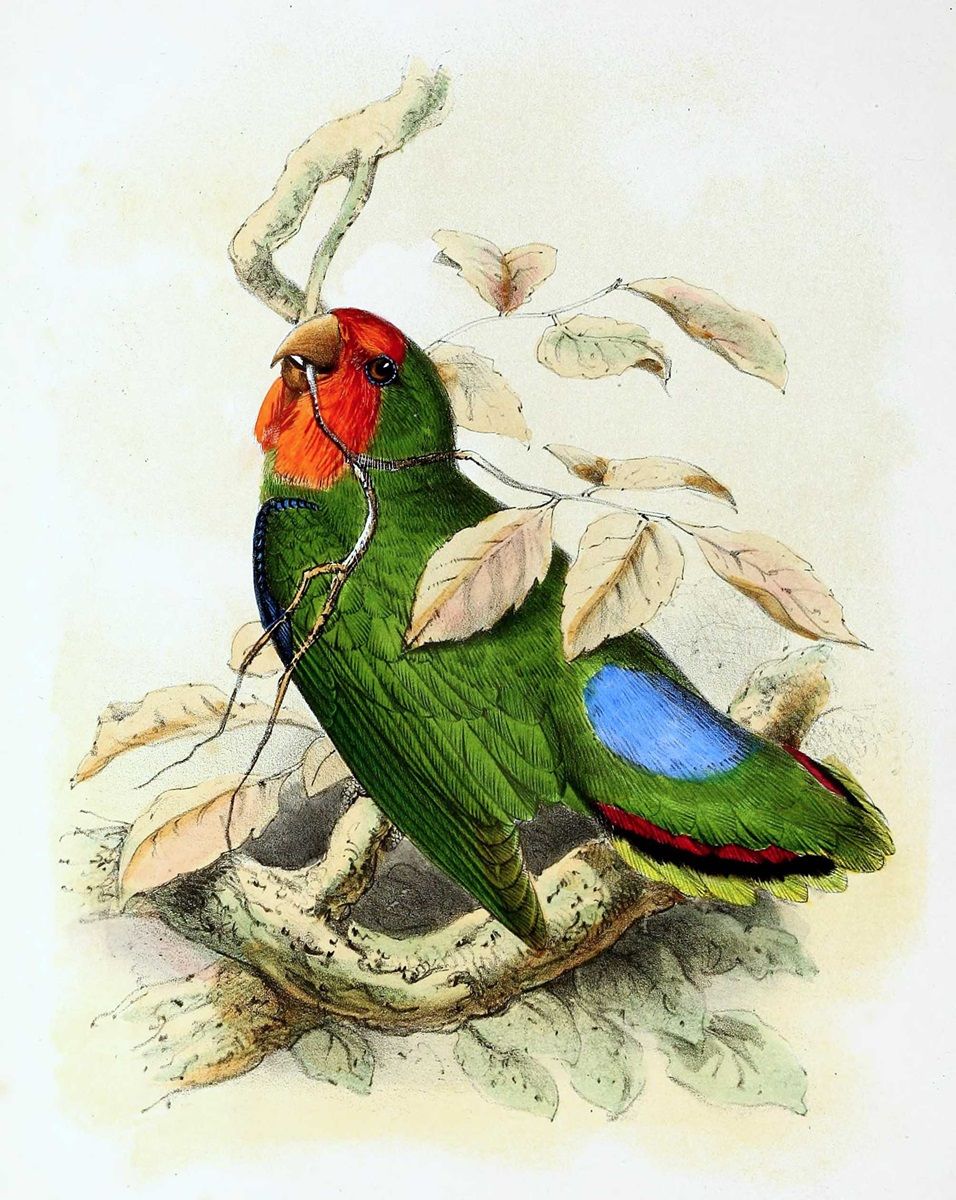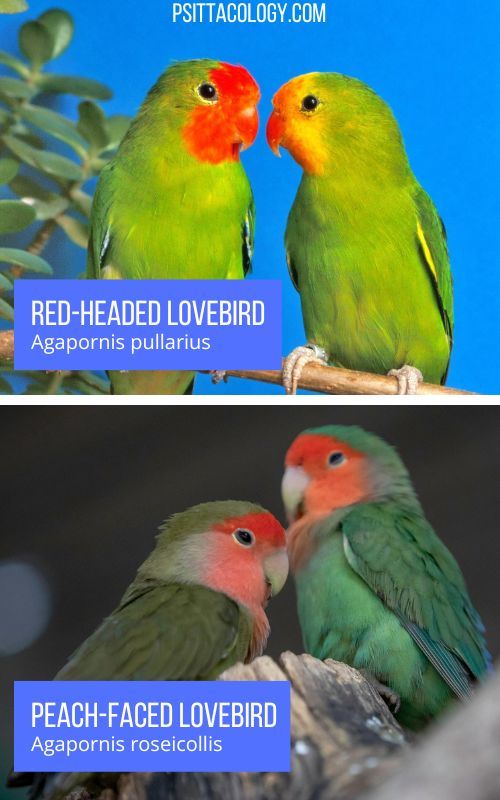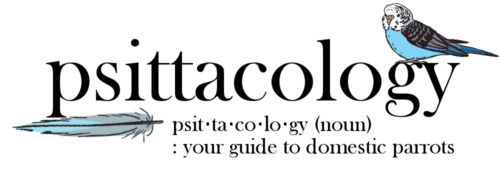Here’s a parrot you may not have heard of before: Agapornis pullarius, more commonly known as the red-headed lovebird. Unlike some other lovebirds, which are among the most popular pet parrots overall, this species is rarely kept in captivity due to its stress-prone nature.
Below, you can find everything you need to know about the red-headed lovebird, including where it’s from, what it eats, and what we know about keeping it in captivity.
| Name(s) (common, scientific) | Red-headed lovebird, red-faced lovebird, Agapornis pullarius |
| Natural habitat | West to Central African tropical savannah |
| Adult size | Up to 15cm (6″) in length, 45 grams |
| Lifespan | 20 years |
| Noise level | Low (for a parrot) |
This post contains affiliate links. If you make a purchase, a small percentage will go directly to Psittacology at no additional cost to you. Thank you for supporting Psittacology!
Red-headed lovebird range & natural habitat
Like all members of the genus Agapornis, the red-headed lovebird is naturally found in Africa. Specifically, this species occurs in a straight but patchy band running from western sub-Saharan Africa through Central Africa (as far west as Guinea and as far east as Ethiopia).
In its natural range, the red-headed lovebird is mostly sedentary (not nomadic). It prefers tropical lowland savannah. The species appreciates the presence of some trees, but doesn’t like dense primary forest.
Red-headed lovebirds usually travel in pairs or small flocks of up to a few dozen birds. They occur at an altitude of up to 2,000m (~6,550ft), though usually lower.
Conservation status
The IUCN Red List considers Agapornis pullarius to be a species of Least Concern. This being said, it does note that it’s locally uncommon in most of its natural range.
The population size is unfortunately likely decreasing as a result of habitat destruction, the killing of birds by farmers, and capture for the pet trade. A 2018 study mentions almost 40.000 red-headed lovebirds exported since 1975!
Parr & Juniper (2010) mention:
“Abundance also varies owing to nomadic habits, but a genuine overall decline appears to have occurred in many areas this century. Trapped for live bird trade with large numbers in captivity outside range.”
Parrots: a guide to parrots of the world

Red-headed lovebird appearance
The red-headed lovebird is quite a striking little parrot. It sports two main colors: bright green on the body and bright red on the face and beak. There’s also a dash of blue on the back and a small band of red on the tail.
Red-headed lovebirds are quite similar in looks to peach-faced lovebirds (Agapornis roseicollis). The latter is much more common in aviculture and is probably the most popular lovebird of all. Look at the beak, though: it’s red in Agapornis pullarius and beige in A. roseicollis.
There are two red-headed lovebird subspecies:
- Agapornis pullarius pullarius
- Agapornis pullarius ugandae
Tip: It’s possible to tell a male and female red-headed lovebird apart visually. The female’s face is less brightly colored, leaning more towards orange than scarlet. The same goes for the beak.

Red-headed lovebird diet
Like many other parrot species, red-headed lovebirds are mainly seed eaters. They prefer grass seeds. This includes agricultural crops like millet, which has led to the species being viewed as a crop pest in its natural range.
These lovebirds will also eat (wild) fruits like figs and guava if they can find them.
The red-headed lovebird in aviculture
This species isn’t quite as common in aviculture as some of its lovebird cousins, such as the popular Agapornis fischeri. It’s mostly kept as an aviary bird, and only by dedicated parrot enthusiasts.
The main issue with the red-headed lovebird is that it’s nervous, easily stressed, and picky. Wild-caught birds in particular can drop dead from something as simple as a sudden loud noise, or refuse to eat if they’re kept in a shared aviary with raucous neighbors.
If you want to keep this species, don’t count on a tame pet. Look, but don’t touch.
Housing
If you’re an experienced parrot enthusiast and have managed to find captive-bred red-headed lovebirds for sale, congrats! You can keep these parrots in a heated aviary, preferably solo.
You can also keep Agapornis pullarius indoors. Just pick a nice and large cage (at least 30″/80cm wide) with a bar spacing of around 0.5″ (~1.25cm). Fill the cage with a variety of natural wood perches.
Captive diet
Most red-headed lovebird keepers still raise their birds on dry or sprouted seeds. It’s likely, however, that like most other parrots this species benefits from being fed a high-quality pelleted diet. Veterinarians generally agree this is the more nutritious option.
Aside from their daily pellets, you can feed your lovebirds a high-quality seed mix, plenty of fresh veggies like leafy greens, some fresh fruits, and various other foods like cooked grains and select foraged weeds.
Some extra protein in the form of boiled egg or mealworms also works well, especially if you’re looking to breed your birds.
Enrichment
Like all parrots, the red-headed lovebird is intelligent and bores easily. Since these birds are so prone to stress, it’s extra important to keep yours busy—but you’ll have to make sure to introduce new items gradually to avoid scaring them.
Your lovebirds will need:
- The presence of their own kind: they’re best kept in pairs.
- Plenty of parrot toys: foraging toys are a particularly good choice.
- To bathe: they love splashing around in a shallow dish.
Noise level
This species is considered relatively quiet as far as parrots go, although like all psittacines, it can get loud if it feels like it. Its calls are quite shrill.
You can have a listen over at Xeno-Canto: Agapornis pullarius.
Red-headed lovebird reproduction
Wild red-headed lovebirds breed during the rainy season when food is abundant. The species usually nests in arboreal (tree) termite or ant nests, although it will also sometimes go for nests located on the ground or take up residence in tree hollows created by woodpeckers.
The nest is created by burrowing into the termitarium and reinforcing it with plant bits like grass leaves, a job reserved for the female. Once everything is in order, she lays up to 6 eggs.
In captivity, the fact that it likes to burrow in termite nests and is quite nervous makes this species notoriously difficult to breed successfully. Dedicated enthusiasts have discovered that nest boxes made of cork can work.
If you have any more questions about the red-headed lovebird or if you want to share your own experiences with this unique little African parrot, don’t hesitate to leave a comment below!
Sources & further reading
- Parr, M., & Juniper, T. (2010). Parrots: a guide to parrots of the world. Bloomsbury Publishing.
- Martin, R. O. (2018). The wild bird trade and African parrots: past, present and future challenges. Ostrich, 89(2), 139-143.
